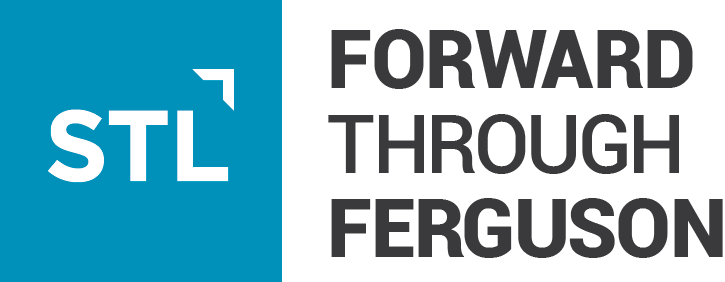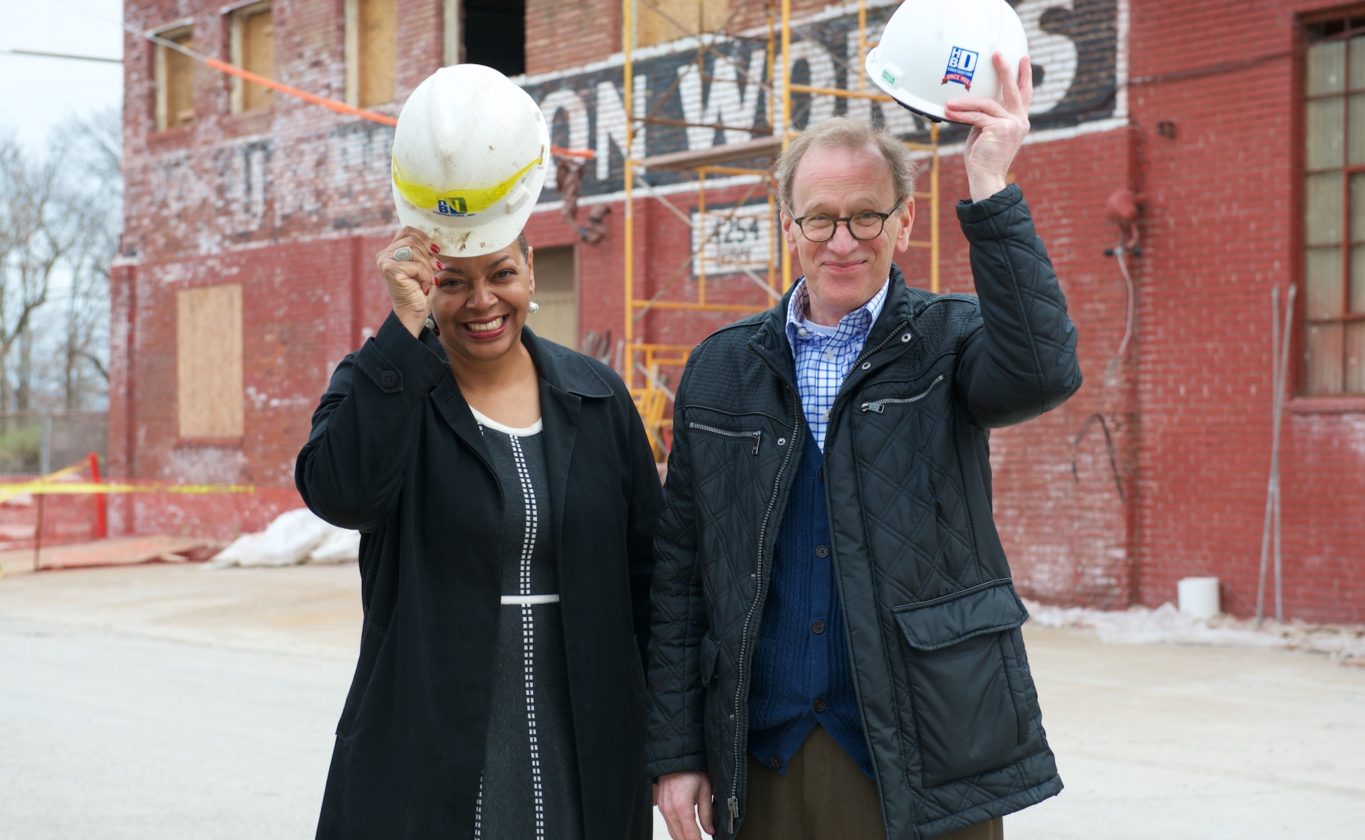This is part of the #STL2039 Action Plan storytelling series in partnership with Humans of St. Louis.
Stacey Easterling: I came to St. Louis to work for Bob in 2015. When I interviewed with him by phone, one of the things we talked about was Ferguson. Being in St. Louis at that time, one year after Michael Brown had been killed, I was a little trepidatious, a little cautious about coming to St. Louis from New Jersey. I remember asking, “What’s Missouri Foundation for Health thinking about now that is in the hotbed of this racial turmoil?” And I remember him talking about how the Foundation was trying to respond to that and that it was a pretty tough time, but that they were wanting to be responsive to what was going on in the community. That conversation was reassuring in terms of my wanting to come here and be a part of that work at that epicenter. So I didn’t run away from it. I wanted to run to it and it was good to know that there was an organization that was aware of it and wanted to do something. I was like, “That’s where I want to go.”
Bob Hughes: And I’ve been at the Foundation for six years. I came here in the fall of 2011, succeeding my predecessor, Jim Kimmey. I grew up in central Illinois and my wife is from Missouri.
What’s the most difficult thing about your roles?
Bob: We have to make some challenging decisions about which things to work on. And that means making decisions about things we’re not going to work on. There’s so much to do. We have to be focused in order to have the kind of impact that we’re aiming for and we’ve got to be strategic. We’ve got to marshal our resources and how we use our staff, how we invest our money, and so on. The needs are just unbelievable. So the challenging thing is that we can always do better. We can always figure out a way to get more leverage to find the sweet spot where we can accelerate some change – the timing, the partners, the activities we can get engaged in – there’s that constant push of, “We can do this faster and better.” That’s the toughest thing, but it’s also what drives us.
Stacey: It’s so funny because he said what I was going to say but in a different way. One of the hardest things we always have to figure out is to say ‘no.’ You ask any program officer, “What’s the hardest thing?” and it’s to say ‘no’ because we know there are so many needs out there and so many people doing so many good things. We hear them saying, “If we just had a little more money we could do more.” What we usually say back is, “You’re doing good work and we know about 100 other groups that are doing really good work, too. We have this hard decision and we want you to help us to decide how do we make that decision?” This work is saying no to some things, but we also know we can say yes to some really powerful things that can have impact. So that’s the other side of the coin that helps you make it through the day. But having to say no to good people doing good work for the right reasons is tough.
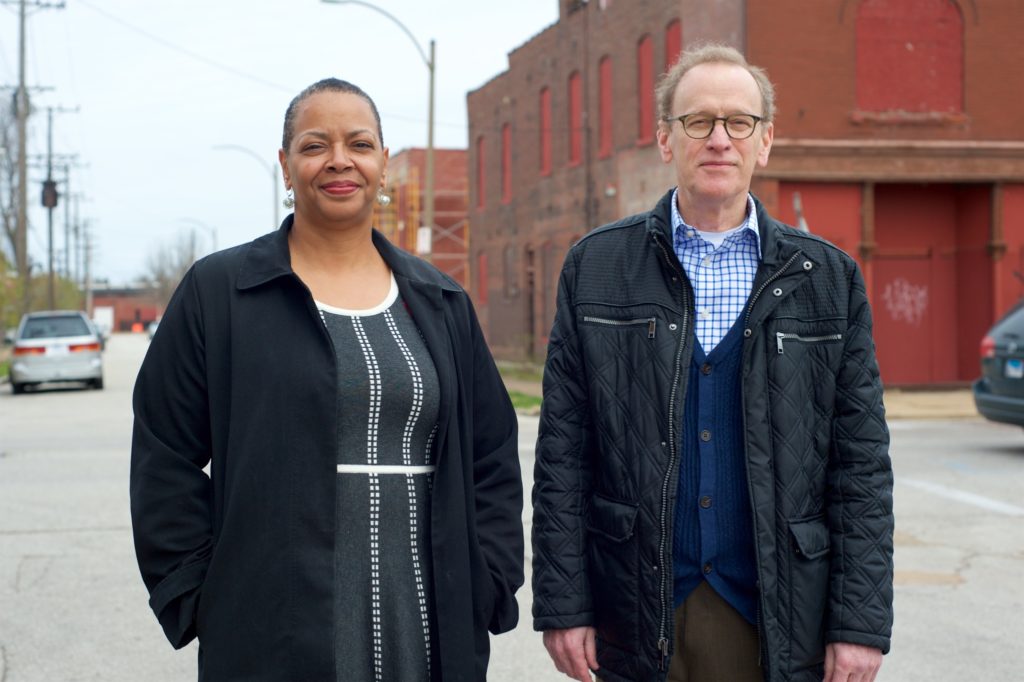
Stacey Easterling and Bob Hughes. (Photostory by Lindy Drew/Humans of St. Louis)
The other thing is that it moves really slow. Sometimes it has to because there are lots of people to consider in everything we do. We didn’t get to where we are overnight, so for me to think that we’re going to change it overnight is unrealistic. Nonetheless, a lot of times we’re impatient because we see people are suffering or in places where we wish they had access to what they needed. I wish we could change things on a dime, but it just doesn’t work that way and it probably won’t last if we do it quick and unplanned. We use strategy, we’re thoughtful, we engage all the right people to make something that has buy-in and can last. So whenever I have something I know we can’t do, I have to look at the other side and say, “Well, at least we can do this and still make a difference on this issue in a significant way.”
Whenever I have something I know we can’t do, I have to look at the other side and say, “Well, at least we can do this and still make a difference on this issue in a significant way.”
What calls to action have been achieved through your work or which ones are you dedicated to working on?
Bob: The Ferguson Commission and the way it did its work was a real gift to us. Community processes are messy, and when you start from the bottom up and really take community participation genuinely, it’s going to be messy, and you’re going to clump some stuff together, and then you keep revising. I had gone to several of the commission meetings and was surprised when they came out with their five priorities because I remember looking at the four topics and thinking, “Oh darn it. Health was not there.”
The Commission report laid out so clearly the overarching Racial Equity lens to say, “No, this is about race.”
I remember feeling disappointed at first and I had to say, “Okay, what’s going on in our heads? In my head?” It reminded me that one of the Foundation’s values is humility and how important it is to recognize, and particularly important for foundations, to make every effort to understand the perspectives of others rather than ours. And it hit me. To me, it was obvious that these are health problems because we think of health quite broadly, including the underlying determinants and structurally. The Commission report laid out so clearly the overarching Racial Equity lens to say, “No, this is about race.” So it was helpful for me to put on a different set of lenses.
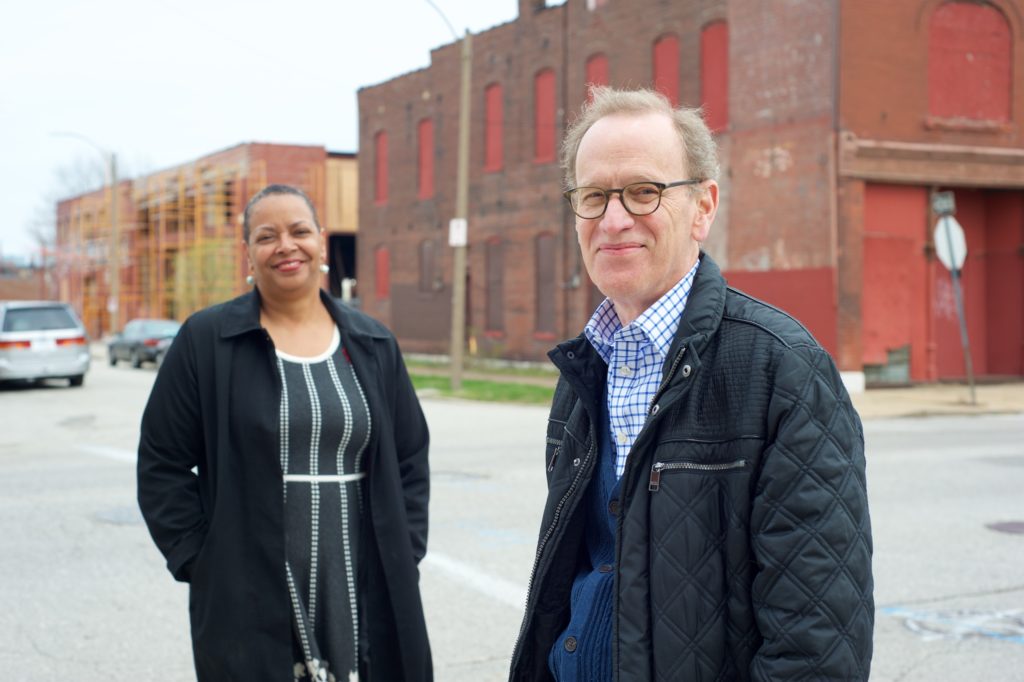
We do a lot of work before we invest in an area. Stacey and her staff do their homework and try to get the landscape and get up to speed on who’s already doing what so we can figure out where we can move things along. So on a more pragmatic level, we took advantage of the Ferguson Commission report as almost having done that job for us. They did the vetting to say, “This is what’s important.” Then we printed it in-house, made everyone copies and handed them out.
Everyone put their post-it notes in there and went through the report to see the whole list of the 189 calls to action and figured out those that were tied to health. We went down our list and said, “Where are there overlaps?” And then we took it to the board and said, “Look, we think this is important. We’re going to use the commission report as the staff work. We don’t know exactly where the low-hanging fruit is on these things, but here are the areas where we think there’s a good possibility.” And they allocated $6,000,000 to work on that stuff. The staff got organized in teams and got to work.
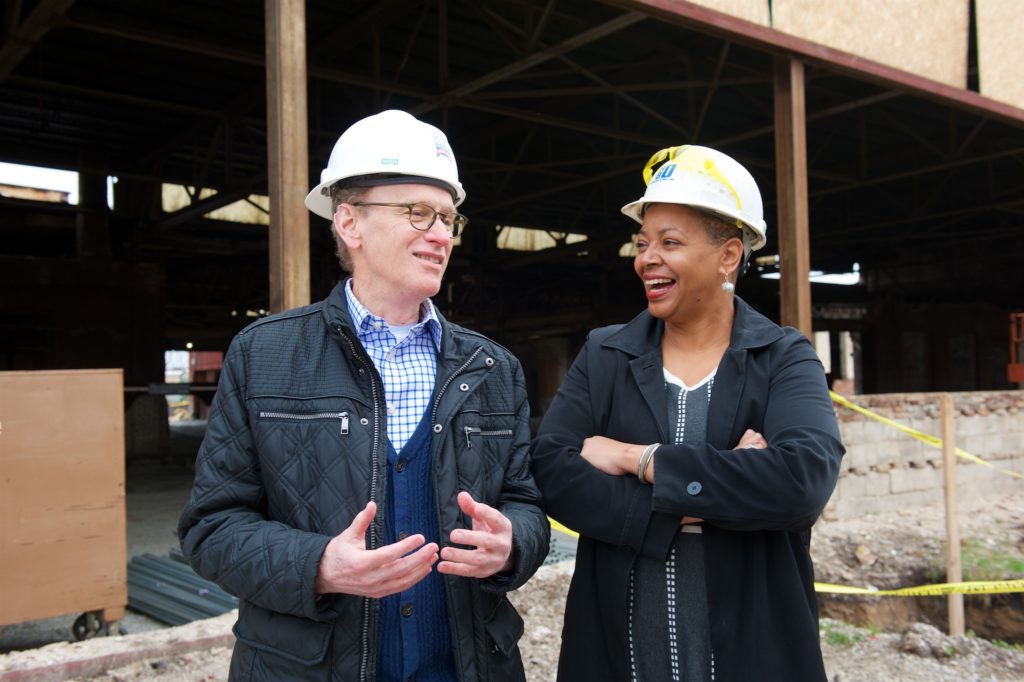
Stacey: We worked together and created teams across departments. So communications, programs, health policy, and strategy and learning were all at the table in ways that we had not worked before. It was elevated to a new way of working. And, like Bob said, it’s not that all of the 189 calls to action weren’t important, but what we had to figure out was where could we possibly make a difference and do something about it. We took six of them and said, “Let’s go out and talk to the players. Let’s see who’s doing what. Let’s learn.”
We identified some really good projects. Some of them we had already been in the loop about, but some things we were uncovering for the first time. It was an opportunity for us to seize the moment and be responsive and strategic about how we would invest. We saw some places where we could fit, and one was Alive and Well STL because trauma was at the root of a lot of health issues. At the time, they wanted to do more community work and we supported them in enhancing the work that was in place. They had already connected with Kansas City, which had a great model and we knew it was evidence-based, and we said, “Let’s get this in St. Louis and expand it.” It all came together, and we knew it was probably going to be a winner.
Something else we had supported, but we knew was in lockstep with the Ferguson Commission, was For the Sake of All. We invested in Jason Purnell’s model, and we were able to deploy our staff to help him do more with school-based health, child development accounts, and things like that. Another priority for us was food insecurity. The report highlighted how access to healthy food was an issue in neighborhoods. There were some things we had done in this particular area, and we had expertise in-house that could scour the landscape to see what was going on.
We also looked at juvenile behavioral health and supported the Shut It Down project, led by the late Dr. Norm White at SLU, to look at preventing the school-to-prison pipeline, so working with young people and making sure they have the behavioral health resources they need so that they’re not getting into the juvenile criminal justice system. It was a partnership with St. Louis Public Schools and seven pilot schools where they were trying to keep middle schoolers in school. The data had shown that, based on race, Black kids were being expelled when it was really just issues that needed to be addressed from a behavioral health perspective.
It’s not that all of the 189 calls to action weren’t important, but what we had to figure out was where could we possibly make a difference and do something about it.
We wanted to do something immediately. We felt like there were some things after the actions were laid out that were already begging for support and made a lot of sense. We agreed, “Let’s just do them because we could take action and our board had said to go for it.” What it did was allow us to get to know the players, start building those relationships, and then we could get into the next level of conversations.
Bob: It reminds me of a governmental perspective and having shovel-ready projects. Of course, the challenge is that stuff is not usually shovel-ready and projects aren’t usually ready either. There were some things that we started on and did some good work on that turned out not to be low-hanging fruit, but a little higher up the tree. So, for example, the work that we’re now supporting for these level-one trauma centers within four hospitals. They’ve all joined together and are working on a violence prevention intervention program.
Stacey: As people come in with gunshot wounds or because of violence, they have social workers that they’re pairing them up with to get them the resources they need that will prevent them from retaliating and ending up back in the hospital. It took 18 months for that program to happen whereas Alive and Well STL was six months into it. That was four hospitals that, as far as we could tell, had not worked so close on the ground together and they were not the ones that said, “Hey, let’s get together.” Wash U was the independent party that stepped in to herd them together and got them to come to an agreement on what the goals would be to get everyone to share data.
Data sharing never happens across systems. So they all saw this as important enough to share data and they said, “We won’t ask the Foundation to pay for it. We’ll even share it and make that transaction with no cost to anyone else,” which is unprecedented. So it took a while after the data part to just work out logistics. All were willing. It just took time. But it’s a good story to talk about partnership because there was very little posturing once there was a neutral party. So they were willing to let a third party manage it and put a stake in it.
Bob: I think it’s important to highlight where the work of the Foundation was in all of that and when it was. To the extent that people know about foundations, and many don’t is, there’s an understandable inclination for the frame in which they can usually think about foundations as a charity. So that means awarding money or giving money. And that, of course, is a significant component of what we do. But this example illustrates how the work that we do is often before that happens. So what gets visible is often after a lot of work in establishing formal relationships with, in this case, five organizations — a university, and four hospitals – and hammering out all those details with data and patient flows and agreements among all of us, thinking that through, and helping make that happen. Everybody started with goodwill, but that’s not enough. There’s a lot of work that goes on and the team did the work.
Stacey: And we made it a zero-sum in that everybody was going to get part of this project supported.
Bob, you said in an article that, “We have serious racial problems in our region and a lot of hard work to do in the future for the good of all of us. These are our problems. These are not ‘their problems.’” It’s a beautiful quote, and it’s a beautiful quote to hear from a White male who’s the head of the Foundation. Can you tell me more about why you were able to say that?
Bob: In some ways, I think of it almost as so obvious that it doesn’t need to be said, but it does need to be said. We all are in this together and what happens to other folks affects us. It may not be immediate. And sometimes because of either geography or blinders or a whole host of reasons, people don’t see that. But, it’s true. And where that leads us is to understand that the problems are all of our problems. We own them together. We all have a piece of them and we all have a responsibility to do something about them.
At the Foundation, how do you bring Racial Equity into the conversations, the culture, the decision making process, the collaborations, and consensus-building?
Bob: I don’t think there’s any magic bullet. I think we work at it. We’re getting better. We help each other and we remind each other. Establishing, reinforcing, and cultivating a culture of trust and respect for one another has been a central platform for that. We ask ourselves the very same question you asked constantly.
Stacey: I’ve worked in several foundations before and this is the first one where the mission and the values are right up front in your face. Anyone here can quote our core values. There are only four and they are humility, integrity, equity, and commitment. We start with that base and around our Foundation it’s talked about. And we wonder, “How do we operationalize equity?” And by using all four of those as our guide, our North Star all the time, we recrafted our mission statement and our core values with the board and staff, and now we’ve tried to keep them at the forefront and incorporate them in all that we do. We haven’t finished because we’re still working on it every day. We operate from that place and that’s different. It’s also dynamic in that it never ends. We’re always in this learning mode to do it better, but it’s nice to have that North Star. That’s the place where we all agree. If we’re don’t agree on that other stuff, we still agree on our four values.
If our mission is to improve health, then we’ve got to take on Racial Equity because the racial disparities are just so powerful and so pervasive.
Bob: It’s important to also inject our mission of improving the health of people and communities that are most in need. You think about the intersection between race and health, and if you look at the data, there it is. It’s right there. And in our region, it’s, if possible, even more front and center. So if our mission is to improve health, then we’ve got to take on Racial Equity because the racial disparities are just so powerful and so pervasive. Arguably, Racial Equity is the linchpin for many of the other areas that we take on in health.
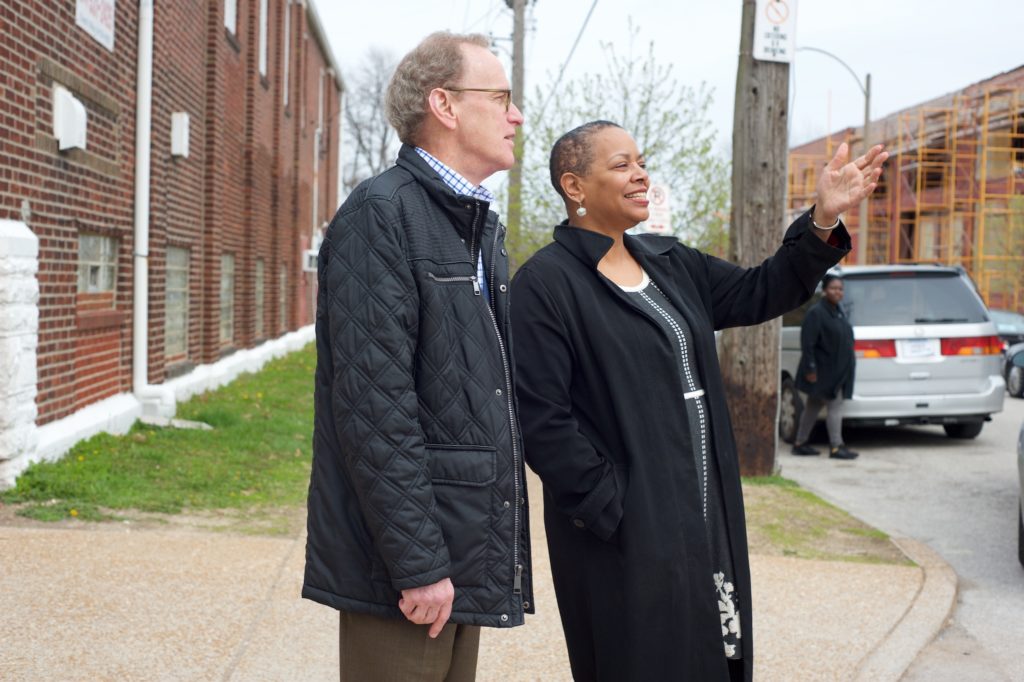
Stacey: You said something, and Bob is way too humble to touch upon it, but you said, “As a White man leading the Foundation.” And I think that’s very important because if you did not see his picture alongside the blog post where you got that quote and if you read all of his posts, that’s a central theme throughout. That’s how he wraps it up. His call to action is that we have to come together. And it speaks volumes because it’s hard for us in this region to digest the viewpoint as a White man sitting at the top of a foundation with a billion dollars. But he gets it.
We’re nowhere near finished. We’re on the road, and the good thing is that we’re grounded and directed in the right way in that we have equity in our heart at all times.
And those words are not just words that he’s putting in a blog post to enhance the image of the Foundation. Those are words that he truly believes in and he lives by and are part of his own value system. In this work, we divide ourselves and separate ourselves with our beliefs and our own experiences, and we have a hard time seeing that it’s possible for the other race to so eloquently say those things, and mean them, and commit to them. It’s coming from the right place, driven by the right things, and that’s what it is for him.
The biggest thing for me is that he didn’t have to. He has a choice and he chooses to go with the way that he feels is right. Not everybody feels like he does. And he’s sitting on a pot of money, so people think, and he has this way to influence where dollars go. He chooses to take the probably less popular way, but what we think is the right way for Missouri.
Knowing how you became comfortable contributing in the way that you do, how can other folks and institutions be thinking courageously about this work?
Stacey: Maybe Bob can talk about the advice, but I’d like to say that we’re nowhere near finished. We’re on the road, and the good thing is that we’re grounded and directed in the right way in that we have equity in our heart at all times. But we are still looking for tools and expertise to help us do it. We could do it given our orientation of our values and our mission. But there are also tools and people to help us so, hopefully, we can do it faster. We are in no way done and we are moving in a way that you’re going to see more from us in how to operate with an equity lens, how to look at Racial Equity as a normal way we operate, and what we’re trying to ensure happens in our work. So I didn’t want to leave with the impression that we’re done or that we can even tell people how to do it because we’re still working on that. It’s laying the groundwork that says that equity is important.

If I tell organizations anything, it’s that they have to come to the conclusion that equity has value. Not just equality, but equity. We’ve made that leap from equality to equity. We know that every group has the ability to access us because we have a website and we put our information out, but some groups have the resources and skills to develop proposals and reach the right staff people because they’re savvy and they’ve been doing it and they have built relationships. We don’t just want to be receptive to only them. We want to also be receptive to those that don’t typically know us and who don’t typically have the resources to develop projects and proposals. So we need to reach out to those folks and talk to them more about their ideas. That’s why we try to now give people what they need and not everybody will necessarily get the same amount.
That visual of the folks on the baseball field has been exemplary for a lot of us in terms of giving everybody what they need and not equal amounts. So some groups need a little more attention and more outreach, and others need less. We can address that very easily with our staff. But we also have to look at the parity of how we distribute our dollars across our region. There are places that have never gotten a grant and we need to find out why. And there are other areas that are really heavy with resources, so how do we look at that? We have to make sure that we’re not just looking at equality in terms of distribution, but equity in terms of districts.
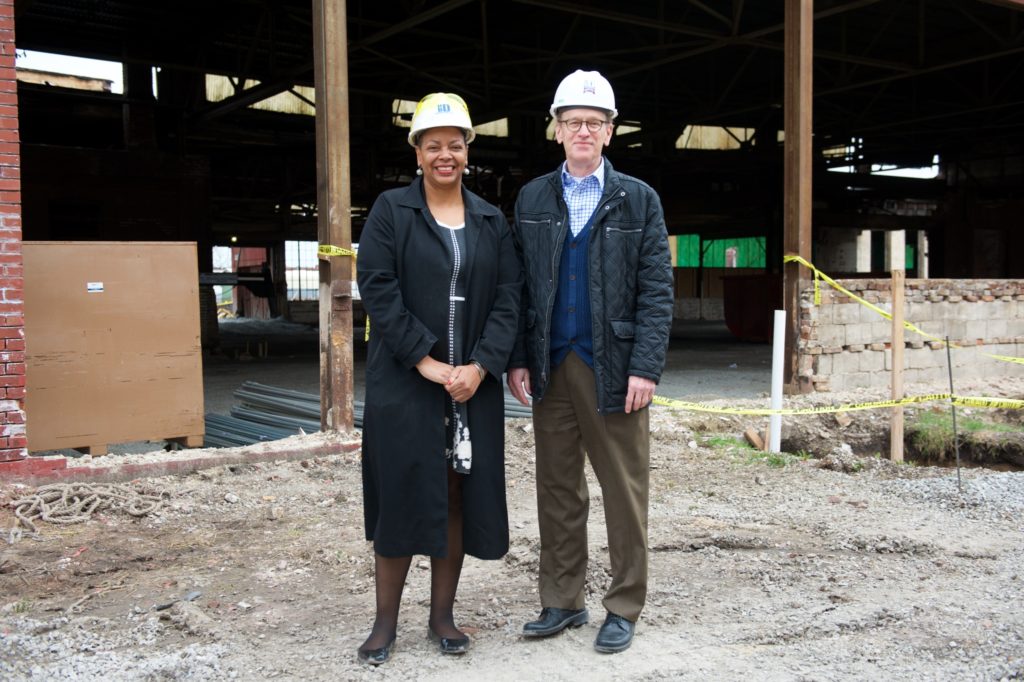
Bob: You’re absolutely right. And that goes back to the Forward Through Ferguson work and the opportunity that gave us to work a little bit differently. Often, our pattern of practice was to put out a request for proposal and get awards back. Then we’d take the best ones. Everybody had an opportunity. So this has been an ongoing conversation within the organization of, “Well, what is fair?” And these are real issues. But if you get to the point of thinking about what it is that you’re trying to do, and who you might want to work with, and where they are, then how do you prospect, how do you reach out to them, and open up a conversation to open up some opportunities so that you can actually be helpful and craft our support both in terms of helping them even think about how to apply let alone what to apply for, that’s a different orientation.
And that work was a real gift of this whole set of experiences to help the staff to see how to do that and work in a different way. And it was because it involved a large number of staff and there were a number that stimulated a lot of conversations about how we were doing the work as well as how that work influenced us as an organization. It just keeps going… even from looking at offering translation services on our website now so that certain groups can apply and understand what they’re applying for or what we have to offer; it’s all about equity and being inclusive, and less about us being a resource, but instead tapping into everyone else in every other community and how they are a resource for us.
How have you seen the benefits of Missouri Foundation for Health affect people at the individual level?
Stacey: The Bloom Café is a new café started by Paraquad and run by people with disabilities. It’s a coffeehouse and offers light lunches, and we supported the startup expenses for that. We went to the opening and it was exciting to see all kinds of folks, some able-bodied and some handicapped, some behind the counter and some in front of the counter, and that was real. One guy is a cook and he has cerebral palsy. The self-esteem, the sense of purpose that he will have, and quality of life he is given from that job is real. The executive director, Aimee Wehmeier, is our Community Advisory Council member and she’s a perfect example of how a person can lead with different abilities. She is the one who should take credit for this, not us. It was her leadership and her vision to have a café like Bloom that will help people like her.
Another example is ATSU Missouri School of Dentistry and Oral Health where we supported that school’s establishment of a campus in partnership with Affinia to make sure people have access to dental services. We have sent people that we know to that dental school where they can receive low-cost oral health care in a time when those services are not covered for many people at all. So those kinds of things that I can see every day help me realize the benefit of our work, like when I drive by the ATSU campus here in St. Louis that we helped to make sure is in the community and people get the care they need.
Bob: Sometimes we’re shy about saying, “We gave them $1 million and…” You’ll notice we don’t use the word funding a lot because we like to think of ourselves as playing so many other roles in people leading healthy lives.
Getting back to the mission, if you’re trying to improve health, that’s not a very exciting way to say we want to change things. And if you want to change things, you’re really trying to either disrupt the status quo, make the good things happen faster, improve the quality of stuff, or start new things that need to be started. One of my favorite projects is Places for People. We supported the work as a partnership between them and the Federally Qualified Health Center, Family Care. Places for People didn’t have the medical services. So Family Care put a clinic inside Places for People to provide clients with their medical care needs. Surprisingly, people are in one body and have one mind and those things are connected. So when they have one problem it actually affects the other. So if you’ve got diabetes and a mental health problem, you need to take care of both of them because they influence one another.
Going back to the first question of how long we’ve known each other, I was thinking about why I hired Stacey. And it’s because she’s really good at things that I’m not good at. I’m kind of an analytic and she just has a set of skills that aren’t my strengths.
How has Stacey helped you do your job better?
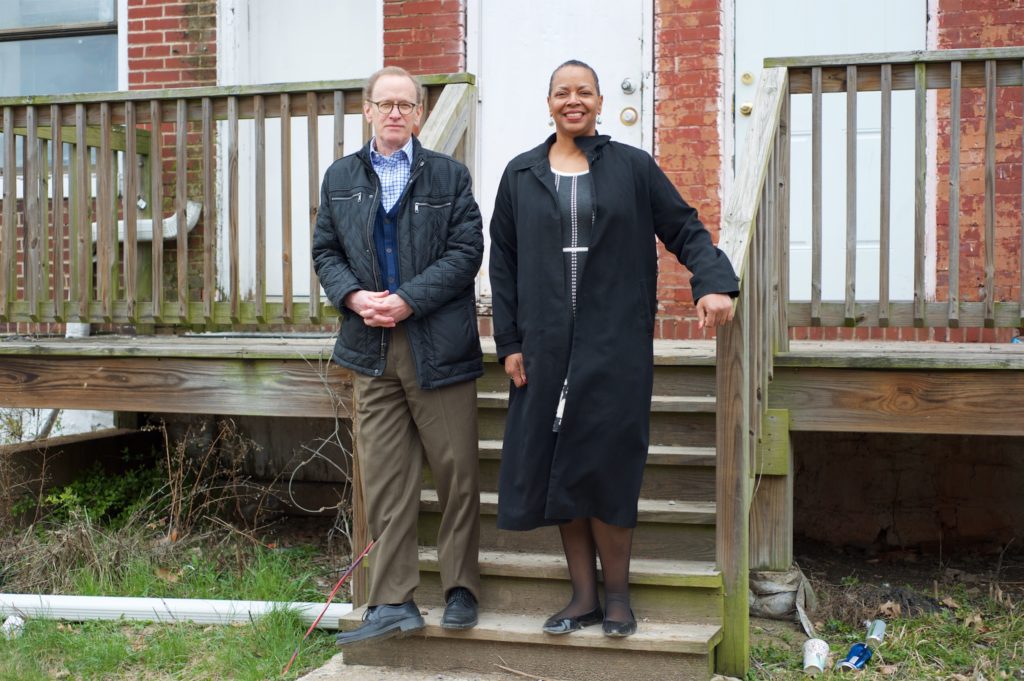
Bob Hughes and Stacey Easterling. (Photostory by Lindy Drew/Humans of St. Louis)
Bob: She asks me questions. And that’s really helpful because they’re good questions.
Stacey: I really do want to say I came to St. Louis because I wanted to work for Bob, and what I have found is that the commitment is what I’m most proud of in terms of where we’re going in our support of advancing health equity and Racial Equity. So we will achieve some of our goals for 2039 of seeing access to resources and people getting what they need the way they needed when they need it. And because Bob continues to push us to make that happen, and him using his influence outside of the Foundation to inspire other leaders to follow suit, I’ve been really proud of him stepping out in a place where he doesn’t have to, but also in a place where it’s uncomfortable and courageous. He’s done blog posts and appearances, and I think people are now perking up in a way that they didn’t before. We’ve done some pretty inspirational things with our dollars, and I think we’re going to do more because of Bob’s leadership that we’re on this path. I don’t envy him all the time, because he doesn’t have to do that. I’m very conscious of that and want to thank him for that.
What is your vision for St. Louis in 2039?
Stacey: This New York Times article came out that said even though Black men come from a high-income family, as they get older they’re income is still going to go down. I have three boys and I kept thinking about Racial Equity. 2039 is going to be when that changes and I can know that they and their children will have a different trajectory in that we’re not even talking about equity anymore. Kids have lived now with women as potential presidents and Black men as presidents. I hope that they are in a space where they don’t have to look at equity as an issue because, by that time, it’s baked in and we all look at it. I’m hoping this next generation doesn’t have to yield the conversation where you have to insert equity into it, but it’s just already there.
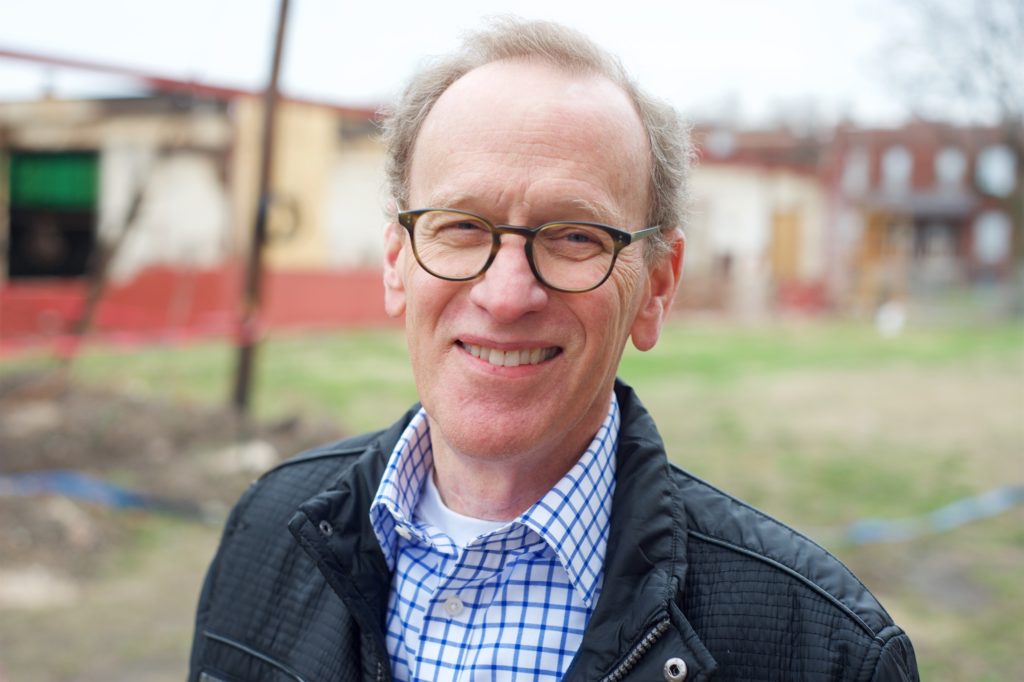
Bob: When you think of 2039, you probably calculate how old you’ll be. So I hope I’ll be alive and healthy. But it’s interesting to think about where we were 25 years back. The questions are, what’s going to happen in the future? And how do you understand what happens to people over time as they run through this crazy society? And what choices will they have or opportunities will they have or not have? What I hope is that by then we have achieved a critical mass that can’t be stopped. The spark will have been sufficiently effective to make irreversible change.
This country has made significant strides, but sometimes we just slip way back. Ferguson sparked something in this region that really was disruptive. There’s been a lot of good work, and one of the things that I was a little concerned about, based on what’s happened and what we learned through some of the work that was done in Ferguson, when people from other communities came and talked to us about what had happened, is that there would be a burst of activity and attention and then things would dwindle down and people might move on to the next thing. I’m actually optimistic that things here are beginning to take root, and that we can establish some momentum. And that our challenge, wherever we are institutionally, individually, within neighborhoods and families, whatever the context, is that we keep pushing and making progress in all different ways.
We don’t know how change happens really. Ultimately, we’re all guessing at this, right? But if we can sustain that momentum and continue that push, we’ll make some significant progress. And if we get to 2039 and keep that going, I think there’ll be a critical mass and then we will have made a difference. In the best of all possible worlds, St. Louis could be a leader in that.
Stacey: What’s interesting is that this type of work will not allow the toothpaste to be able to go back into the tube. I mean, it’s open and it’s coming out and you can’t put it back. These are the disruptors that’ll keep us accountable and learning and talking. What I’ve noticed since I’ve come to St. Louis is that there was a different way of talking before Michael Brown died. I came when people were uncomfortable talking explicitly about race, but now I noticed that there are more conversations and I hope that’s what leads us to that path.
Stacey Easterling
MFH Vice President of Programs
Bob Hughes
MFH President and CEO
